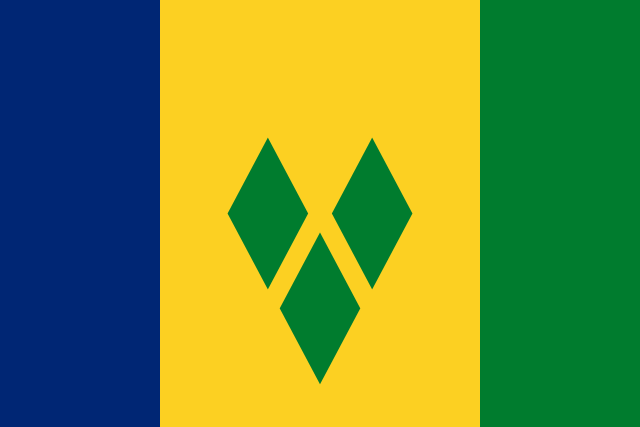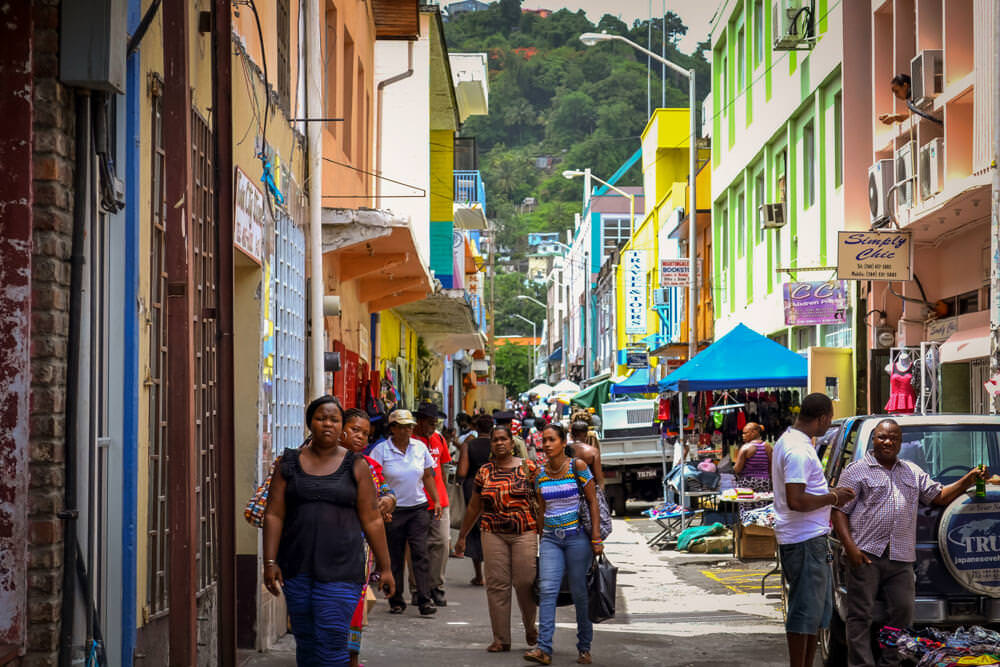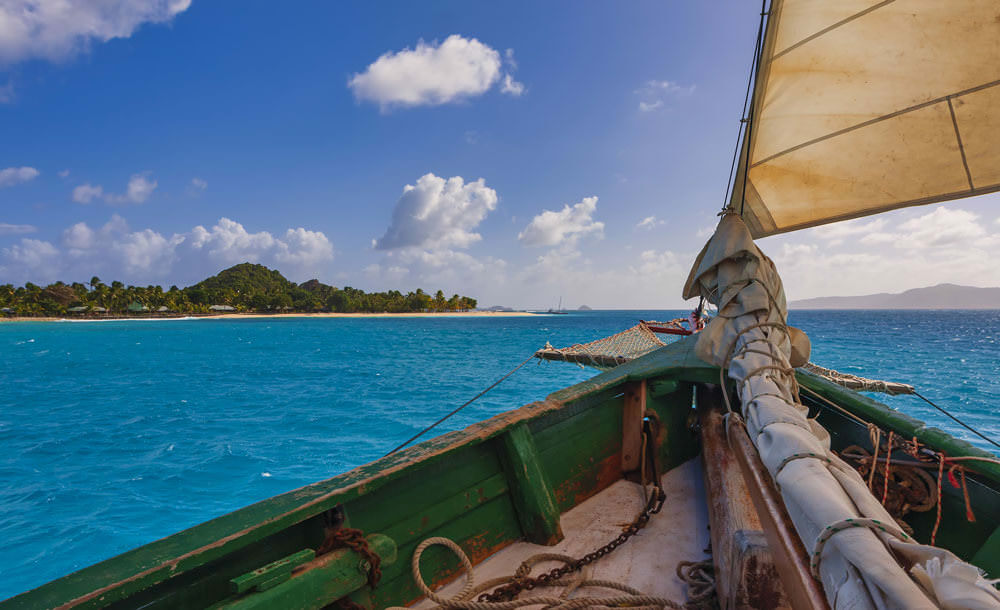St Vincent and The Grenadines

Region: Caribbean & Americas
Gained independence: 27 October 1979
Joined Commonwealth: 1979
Head of State: Ralph Gonsalves
United Nations HDI Ranking (2020): 91
Official language: English
Timezone: GMT-4hrs
Currency: Eastern Caribbean dollar
Doing Business Rankings (2020): 130
Saint Vincent and the Grenadines is an island country located within the Lesser Antilles, in the Caribbean Sea, stretching along the southward direction towards Grenada. The island of Saint Vincent lies about 32 km southwest of Saint Lucia and 160 km west of Barbados.
St. Vincent and the Grenadines is a Caribbean island nation consisting of one large island, St. Vincent, and a group of smaller islands, known as the Grenadines. The topography of the islands varies, with St. Vincent being more mountainous and the Grenadines being flatter and more coral-based. St. Vincent has a volcanic origin and is dominated by the active volcano La Soufriere, which is located on the northern part of the island. The volcano is the highest point in St. Vincent and the Grenadines, with an elevation of 4,049 feet (1,234 meters). The mountainous terrain of St. Vincent is characterized by steep ridges and deep valleys, with a central mountain range running from north to south. The island also has several rivers and waterfalls, including the Falls of Baleine and the Dark View Falls.
The Grenadines, on the other hand, are composed of small coral islands and cays, with some volcanic formations in the northern islands. The islands are generally flat and low-lying, with sandy beaches and coral reefs. The largest island in the Grenadines is Bequia, which has a hilly terrain and is surrounded by coral reefs.

Demographic
The population of St Vincent and The Grenadines reached 104,332 in 2021 and is growing steadily at a rate of 0.32 percent. Approximately 40% of the population of St Vincent and the Grenadines is aged 25 or below. The islands’ urban population has been rising progressively for some years since the early 2000s, when over 55 percent of citizens lived rurally. As of August 2020, however, 53 percent now live-in urban areas, which is mainly attributable to growing secondary industries, such as tourism and construction, which are contributing an increasing amount to the economy.
Almost two-thirds of the population is of African descent and an estimated 20% are mixed with the remaining population being of indigenous descent, East Indian, European and several others. In terms of religious practice, the majority of civilians practice Christianity; around 75%, are Protestant and 6.3% are Roman Catholic. The remaining practice several other religions including Islam, Hinduism and Rastafarianism.
The official language of the country is English. It is widely used as the primary means of instruction for education, media from visual, audio, to print. Aside from that, there is a rich selection of vernaculars which include Vincentian Creole, French Patois, Portuguese, and Bhojpuri which are considered more so the lingua francae of the nation.
History
The first human population to settle in St Vincent were the indigenous Carib people. They are believed to have settled on the islands around 1500 BC; they were skilled farmers and fishermen, and were known for their prowess as warriors. They lived in villages that were led by a chief, and had a complex social structure that included different classes and roles within the community. It is important to note that while the Caribs were the dominant group in St Vincent at the time of European contact, they were not the first people to settle in the islands. It is said that the islands had been inhabited by the Ciboney people, Indian people of the Greater Antilles, until they were displaced by the Arawak people hailing from Venezuela and the West Indies, although it is unclear how they drove out the Ciboney settlements. By the 17th century, intermarriage between the Caribs and the African settlements, which had arrived from plantations in Barbados and other European occupied territories, resulted in a substantial demographic knowns as the “Black Caribs” or the Garifuna. Ex-slaves that escaped and landed on the shores of the Grenadines were also part of the intermixed settlements. An interesting fact is that although it was previously said that Christopher Columbus was the one who first visited the island and gave it the name Saint Vincent Jan. 22, 1498, a day that used to be celebrated as “Discovery Day”, it is now known that he was still in Spain on that day, and there is no evidence to suggest him ever being in Saint Vincent.
Despite resistance from the local population against external European forces, the French managed partial settlement on the western coast of the island at the start of the 18th century, largely because the local population thought to gain their support rather than conceding to the comparatively more aggressive British forces. Even when the Treaty of Paris ratified in 1763 brought St Vincent under British administration, the Caribs continued to struggle against them and the French seized the territory in 1779, though just 4 years later they were driven out by the British and had to relinquish all claims as stipulated by the subsequent Treaty of Versailles. The Caribs led two wars from 1772-1773 and 1795-1796 against the British colonists but were defeated and were consequently exiled to Honduras; some managed to migrate to Belize while others that chose to remain went into hiding in the interior parts of the island. They remained there until the legislature of the colony pardoned them in 1805.
In 1763, following the Treaty of Paris, Saint Vincent was incorporated into the Windward Islands administrative union, along with Grenada, Dominica, Tobago, and the Grenadines. The union had a shared representative assembly and was headquartered in Grenada. However, the union dissolved soon after, and the islands were given separate representative assemblies. In 1791, the Grenadines were divided between Grenada and Saint Vincent, with Saint Vincent assuming administrative control over the northern islands, as they were geographically closer and easier to manage. This system remained in place until 1877, when a crown colony system was introduced, and a governor and nominated council managed the islands on behalf of the British crown.
The plantation economy thrived and produced commodities such as sugar, cotton, coffee, and cocoa, relying on enslaved Africans for labor. The emancipation of slaves in 1834 led to an increase in the bargaining power of the former slaves, thereby reducing the planters’ total control. Later in the century, Portuguese and South Asian laborers were brought in to increase competition and weaken the position of emancipated people in the labor market. In the latter half of the 19th century, Saint Vincent suffered a major economic setback as sugar prices plummeted, leading to a depression that persisted until the end of the century. The island was also hit by a hurricane in 1898 and the eruption of Soufrière in 1902, which inflicted further damage on the agriculture sector, impeding the economic recovery and marking the end of the sugar industry. Arrowroot and Sea Island cotton took over as the primary export crops, until they were eventually replaced by bananas in the 1950s.
Throughout the 20th century, the main struggle in Saint Vincent was to replace the crown colony system of government with a more representative system. The establishment of a legislative council in 1925 marked a significant step towards achieving this goal, but the majority of descendants of slaves were excluded from the process due to limited franchise. This led to efforts to expand the franchise and gain further constitutional reforms, culminating in the formation of a federation of islands. Riots in the mid-1930s, sparked by fallout from the Great Depression, paved the way for further constitutional reform in 1951, when universal adult suffrage was introduced. Saint Vincent also joined the West Indies Federation that existed between 1958 and 1962. A new constitution was adopted in 1960 and Saint Vincent became a state in association with the United Kingdom on Oct. 27, 1969.
It had become a member of the Caribbean Free Trade Area on July 1, 1968, then joined the Caribbean Community and Common Market (CARICOM) in 1973 and the Organisation of Eastern Caribbean States in 1981. After the collapse of the West Indies Federation in 1962, efforts began to create a political union among different groupings of the federation’s former members, although they did not bear fruit. Most of the islands sought independence individually. Independence for Saint Vincent was achieved on Oct. 27, 1979. Shortly after, the political entity became known officially as Saint Vincent and the Grenadines. The new government was formed as a constitutional monarchy and became a member of the Commonwealth. The country held its first elections in December of that year.
Key dates
1500s- The first indigenous people, the Ciboney, settle in St. Vincent
1600s- The Carib people settle in St. Vincent and push out the Ciboney
1719– The French establish a permanent settlement in St. Vincent
1763- The Treaty of Paris cedes St. Vincent to Britain
1772– The First Carib War ends with a British victory
1796 The Second Carib War ends with a British victory
1834- Slavery is abolished in the British Empire, including St. Vincent and the Grenadines
1902- The Soufrière volcano erupts and causes significant damage
1951- St Vincent is granted universal adult suffrage.
1958-62- St Vincent becomes a member of the West Indies Federation.
1969 – St Vincent granted internal self-government but Britain retains responsibility for foreign and defense affairs.
1979 – St Vincent and the Grenadines become independent; center-left St. Vincent Labour Party (SVLP) leader Milton Cato becomes Prime Minister
1984 – James Mitchell becomes prime minister after his centre-right New Democratic Party (NDP) wins general election.
1989 – Mitchell returned to office after his NDP won all parliamentary seats.
1994 – Mitchell and the NDP returned to office once again, but with a reduced majority.
1998 – Mitchell and the NDP win a fourth term in Parliament.
2000 – Mitchell resigns, Finance Minister Arniham Eustace is appointed next Prime Minister.
2003 – The country is removed from a list of nations with unsatisfactory anti money laundering policies
2009 – Voters reject the proposal to replace the monarchy with a republic in a constitutional referendum.

Legal System and Government
The country is a parliamentary constitutional monarchy. The Queen of England is the head of state who is represented by an appointed governor-general. The prime minister, who is the leader of their majority party, is the head of government. The legislature is unicameral consisting of the House of Assembly, which has 15 representatives elected by universal suffrage and 6 nonelected Senators.
As a result of its colonial history, St. Vincent and the Grenadines’ legal system is based on English common law. The Eastern Caribbean Supreme Court allocates one High Court judge to hear cases in the country. Magisterial courts are divided amongst the country’s six parishes and have both criminal and civil jurisdiction. Such courts are part of the Lower Judiciary, which is accountable to the country’s Supreme Court. Appeals from the Supreme Court can be heard by the Eastern Caribbean Supreme Court or the Caribbean Court of Justice. Final appeals may be made to the Judicial Committee of the Privy Council in the United Kingdom.
Economy
St Vincent and the Grenadines is a middle-income country with a small open economy and Small Island Developing State (SIDS) status. The economy largely relies on agriculture, tourism, the construction industry and remittances. The agricultural sector contributes an estimated 7% of the GDP and employs 10% of the labour force; in the decade prior the contribution of the sector was far more significant due to the export of bananas which has waned over time partially due to the loss of the preferential access to the European Union (EU). As of 2021, banana exports contribute 1.49% of GDP; this decline notwithstanding, the agricultural sector of the nation still holds importance due to the production of arrowroot, cassava and yams. The uptake of construction projects and the overall improvement of the construction industry in the nation has led to the increase in contribution of the industry sector which now contributes 13.7% of GDP and employs 20% of the workforce. Apart from construction, food processing flour production and rice milling are also important as the manufacturing industry for these products and smaller cottage industries contributes 4% of the GDP contribution of industries.
The services sector is the largest contributor of GDP, currently contributing 62.7% of the GDP and employing 70% of the workforce. Financial services and the tourism industry are the pillars of the services sector which explains the sharp decline of the nation’s GDP due to the COVID-19 pandemic. As a SIDS, the nation is more prone to external shocks including natural disasters and global supply chain disruptions.
Trade
The country’s GDP was recorded to be US$0.90 billion in 2021. For the same year, merchandise exports amounted to US$34.5 million and the top commodities exported included milling industry products (26.2%), food residues and waste (14.9%), fish, crustaceans, molluscs and other aquatic invertebrates (14.7%), and beverages, spirits and vinegar (6.1%). The main purchasers by nation were Barbados (16.6%), Saint Lucia (16.2%), the United States of America (14.5%) and Dominica (10.4%). Merchandise imports in 2021 amounted to a total of US$372.4 million primarily comprising of mineral fuels, oils and products of their distillation (12.5%), machinery, mechanical appliances and parts of thereof (8.9%), electrical machinery, electronic equipment and parts thereof (7.0%) and meat and meat offal (4.5%). These items were primarily sources from the United States of America (46.5%) as well as Trinidad and Tobago (9.4%) and China (6.6%).
The country is party to several trade agreements, including CARICOM and CARIFORUM. Trade between South American countries, such as Colombia and Venezuela, is made easier due to the agreements established between CARICOM members and these countries.
Investment Opportunities
St Vincent and the Grenadines is a politically stable and safe nation with a young, agile and English speaking skilled labour force; it is also amongst the least corrupt Caribbean nations.
In 2018, St Vincent and the Grenadines reportedly welcomed US$160.3 million of foreign direct investment (FDI), which accounted for around 17.7 percent of overall GDP and an increase of over 100% as compared to levels in 2020. The government and ‘Invest SVG’, which is the country’s prime investment promotions agency acting under the country’s Ministry of Finance, Economic Planning and Sustainable Development, has stated that the primary focus would be in industry and export diversification, niche markets, touris, international financial services and information and communication technologies with a particular goal of increasing job opportunities.
As tourism is a prevalent industry that stands as an important source of revenue on the islands, it follows that St Vincent seeks to expand facilities such as convention centres, yacht facilities and an increase in professional golf courses. After US$700 million of FDI contributed to the construction of Argyle International Airport, the country also intends to increase the number of large-scale hotels on its islands to accommodate the increase in tourists. Furthermore, the Medicinal Cannabis Authority has implemented legislation for the development of the medicinal cannabis industry to transform the lives of the rural communities as well as to advance the public and private health sectors; the nation has a distinct advantage for growing the crop owing to the availability of rich volcanic soil. Real estate is another area of focus for the government as the construction industry’s advancement, tourism promotion and availability of land makes the nation a perfect destination for investment in luxury resorts, hotels, restaurants and more.
Should foreign investors choose to spend in St Vincent, they would enjoy import tax concessions on raw machinery, machinery, and equipment so as to encourage the development of new tourist destinations and resorts. Investors also benefit from complete or partial exemption from income tax on profits, significant tax holidays, freedom for fund repatriation and allowance for foreigners to procure holding trust company licenses.
Sources
https://data.worldbank.org/indicator/SP.POP.TOTL?locations=VC
https://statisticstimes.com/demographics/country/st-vincent-and-the-grenadines-demographics.php
https://thecommonwealth.org/our-member-countries/st-vincent-and-grenadines
https://www.doingbusiness.org/en/data/exploreeconomies/st-vincent-and-the-grenadines
https://www.worldometers.info/demographics/saint-vincent-and-the-grenadines-demographics/
https://worldpopulationreview.com/countries/saint-vincent-and-the-grenadines-population
https://data.worldbank.org/country/VC
https://www.heritage.org/index/country/saintvincentgrenadines
https://issuu.com/caribank/docs/cdb_economic_brief_2018_-_svg
https://tradecouncil.org/st-vincent-and-the-grenadines-economic-statistics-2019/
http://www.sice.oas.org/ctyindex/VCT/VCTagreements_e.asp
https://www.economy.com/saint-vincent-and-the-grenadines/indicators
https://data.worldbank.org/indicator/NV.SRV.TOTL.ZS?locations=VC
https://www.indexmundi.com/facts/st.-vincent-and-the-grenadines/foreign-direct-investment
https://www.investsvg.com/about-us-3/
https://www.gov.vc/index.php/citizens/economy
https://businessviewcaribbean.com/argyle-international-airport-goods-passengers/
https://www.gov.vc/index.php/business/investment-opportunities
http://www.gov.vc/index.php/business/advantages
https://www.worldatlas.com/articles/what-languages-are-spoken-in-saint-vincent-and-the-grenadines.html
https://www.britannica.com/place/Saint-Vincent-and-the-Grenadines
https://www.bbc.com/news/world-latin-america-20007543
https://tradingeconomics.com/st-vincent-and-the-grenadines/gdp
https://oec.world/en/profile/country/vct
https://www.state.gov/reports/2019-investment-climate-statements/saint-vincent-and-the-grenadines/
https://www.gov.vc/index.php/home/cabinet/29-business/advantages